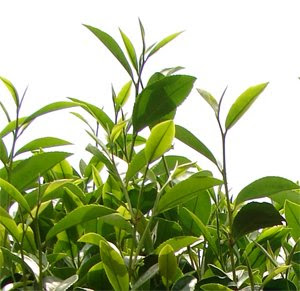 The great author, Michael Pollan, wrote a book called the "The Botany of Desire" that discusses man's relationship with several plants. He asked that we look at the world from the plants' view.
The great author, Michael Pollan, wrote a book called the "The Botany of Desire" that discusses man's relationship with several plants. He asked that we look at the world from the plants' view.When analyzing and considering tea, we should remember that tea was not originally designed for our pleasure. Like all plants, tea evolved according to its own propagation peccadillos and survival needs. When we talk about tea and components of the leaf, we tend to focus on what they do for humans. Caffeine keeps us awake. Certain polyphenols help keep us healthy. The warm beverage cheers our souls and nourishes. But from the plant’s point of view, from nature’s standpoint, why are these components present inside the green leaf of a perennial plant? How did this humble plant become the most popular beverage on the planet? Tea, like most plants, just wants to grow. Its growth is fueled by glucose, which it magically creates out of sunlight and carbon in the air. Also tea can not run from its predators, it remains firmly planted in the ground. So to survive thousands of years, tea plants have developed many different defenses against those pests that would eat the leaves until the plant dies and threaten the entire species.
Caffeine is an important component of tea’s appeal. For centuries it has kept tea-devoted
 Buddhist monks awake and closer to enlightenment during long meditations. We like the gentle stimulation tea provides.
Buddhist monks awake and closer to enlightenment during long meditations. We like the gentle stimulation tea provides.Consider, that caffeine does not serve the same stimulating purpose for the tea plants themselves. It is not the caffeine within that stirs tea leaves to wave at you wildly in the wind, or allows the plant to sit there forever rooted in deep meditation, at one with the ground of being. Research suggests that caffeine helps repel pests. (It is natural OFF.) A bug eats a leaf that contains caffeine, is zapped with repulsion, and moves on.
Similarly, the polyphenols (ECGC and the others) help protect the fragile leaves against fungi, viruses and other harmful microorganisms. Polyphenols also, remarkably, seem to help protect against excessive ultraviolet light. (The plant’s own sun-block.)
Two of the most popular types of teas are green tea and black tea. Both come from the same leaf. The difference is that the green tea is kept green by steaming it immediately after plucking. To make black tea, a leaf is rolled enough to make it limp, so that the polyphenols within mix with an enzyme PPO (PolyPhenolOxidase), also released inside the leaf, and the green tea turns into black tea. Why plants have these reactive substances within them, and why they keep them safely apart (until we rupture them) is still under study. One elegantly simple theory, property of Dr. Peter J. Davies, of Cornell University, suggests that when these two reactive substances coagulate, making tea in the bug belly! – the bug finds the tiny tea mix repellant, and it stops eating the leaf. Experts have unilaterally, in any case ruled out the old theory that polyphenols and its enzyme’s natural role in the tea leaf was to give the Brits a brisk cuppa.
An inherent charm of oolong tea (and, more subtly, of black tea) is its lovely floral fragrance, which derives from at least two sources. One is the reaction between sugars in the leaves and the enzyme PVO (PrimeVerOsidase), which together produce the building block that morphs into various aromas. The other source of oolong’s alluring floral fragrance and taste is the breakdown of the leaf’s fatty acids into a variety of compounds, including Methyl Jasmonate (also found in Jasmine flowers). These, too, help defend a leaf against bugs. Again Dr. Davies: “It stimulates production of proteases that precipitate the digestive enzymes of the insects’guts, ruining their digestion and their lunch!” Thus they promptly cease and desist their tea leaf lunch. It follows, also, that the released aroma serves the same role as a flower’s scent: to attract another insect or animal that might eat the offending bug, poisoned and paralysed with insectile indigestionThere are as many compounds derived from these building blocks as there are indigenous types of invader bugs.
Nature is elegant. All that is needed to make the tea you like, exists in the green leaves. The components are in the tiny leaves to protect those leaves. We love to drink the byproducts of the plant’s self defense. We express this love by carefully tending tea plants throughout the world!








No comments:
Post a Comment